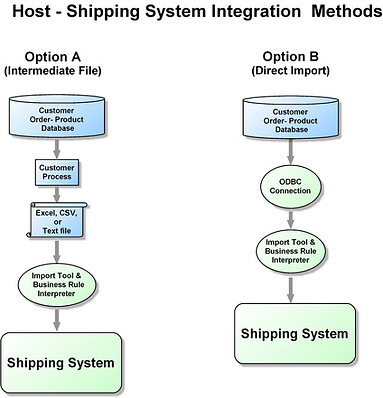 Endicia is a leading provider of internet postage solutions. They offer a robust application called DAZzle which manages your prepaid postage (purchasing, etc) and generates postal shipping labels.
Endicia is a leading provider of internet postage solutions. They offer a robust application called DAZzle which manages your prepaid postage (purchasing, etc) and generates postal shipping labels.
When it comes to low-volume postal shipping, DAZzle is adequate as a stand-alone application. However, for shippers looking for more advanced functionality (such as incorporating additional carriers, batch processing, rate shopping, sophisticated integration, custom labels and more) an integrated shipping solution is necessary.
Here are some of the more common areas where a shipping system with integration to Endicia can add value:
Multiple-Carrier Rate Shopping
In addition to shipping through the postal service, many Endicia users also use UPS, FedEx, DHL and other carriers. In many cases, a primary factor in determining the carrier and service level is the price. So, in order to streamline the use of multiple carriers and to maximize the savings associated with comparing rates, a shipping system capable of automatic rate shopping is necessary.
A shipping system function (commonly referred to as) "bestway carrier selection" enables the shipping software to choose the best (cheapest) method from two or more configurable methods-- such as Priority Mail, UPS Ground and FedEx Home Delivery. Because this happens automatically, bestway solutions are ideal for medium to high volume shippers.
A multi-carrier rate shop screen is an alternative (manual) method for selecting the cheapest method. A rate shop screen is typically a grid or chart of available service levels sorted by cost. The user can select the appropriate method (without consulting other applications, rate charts, the internet, etc). With a single click, all of the rates appear.
Obviously, automatic bestway carrier selection is more efficent, but in many operations, a combination of both methods are used.
Automatic Batch Processing
Batch processing is the automatic printing of multiple shipping labels all. Batch processing is ideal when product weights are known. Since each item does not need to be weighed, multiple shipping labels can be processed all at once (instead of individually.) For example, an internet retailer might downloaded orders received in a shopping cart and print all of the shipping labels at once-- automatically.
Batch processing can be used for a single carrier (e.g., just postal shipments through Endicia) or with multiple carriers-- such as UPS and FedEx too. When combined with other functions such as integration, packing list printing and rate shopping, batch processing can offer dramatic improvements to overall efficiency.
 Host Integration
Host Integration
Users of the stand-alone DAZzle application generally do not have any efficient means of seamlessly integrating shipping data (import and export) with their host business systems or databases.
Integration is one of the most common benefits of Integrated DAZzle partner solutions. The most basic integration involves importing shipping address based on an Order # and exporting tracking #, shipping charges, etc.
More sophisticated integration might include bestway rate shopping codes, additional reference data, package contents, package dimensions and virtually any other relevant shipping data. Integration might also include "business rules" to automatically perform decisions or steps that would normally be taken manually.
Custom Labeling
The DAZzle label designer software is very flexible in its ability to print custom fields, doc-tabs and more. However, in order to take full advantage, integration is typically necessary to pass through the additional label data automatically.
A Case Study
This online retailer of iPod accessories, batteries and chargers downloads orders from a shopping cart into a .csv file once per day. Since the weights for all products are known, the shipper uses a batch processing function in their third-party shipping system (Malvern Manifest System) to generate all labels automatically. The 4" x 8" labels include a customized Packing List section listing the SKU, quantity and description for ever line item within each order. The shipper processes about 200-300 postal shipments daily in fewer than 30 minutes. Prior to implementing batch processing, it took nearly a full day. In terms of operational improvements alone, the return on investment in their third-party shipping system was approximately 5 weeks.


